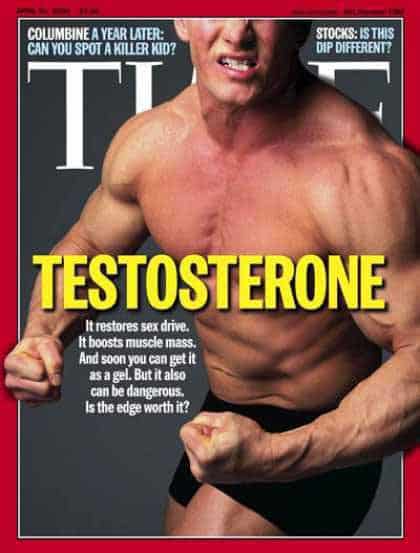Contact Us
 Dr. Delgado is a highly skilled surgeon specializing in gynecomastia surgery. Dr. Delgado has committed a significant amount of his practice to the care and education of men and boys with gynecomastia. Dr. Delgado’s practice philosophy is to provide the highest quality of patient care to the people who seek out his professional services. Dr. Delgado and his staff are committed to understanding their patients' concerns, educating them on their options, and executing the best surgical outcome for each patient. Dr. Delgado is the new owner of Gynecomastia.org since 2010. He has dedicated a significant part of his life and practice to improving the Gynecomastia.org community.
Dr. Delgado is a highly skilled surgeon specializing in gynecomastia surgery. Dr. Delgado has committed a significant amount of his practice to the care and education of men and boys with gynecomastia. Dr. Delgado’s practice philosophy is to provide the highest quality of patient care to the people who seek out his professional services. Dr. Delgado and his staff are committed to understanding their patients' concerns, educating them on their options, and executing the best surgical outcome for each patient. Dr. Delgado is the new owner of Gynecomastia.org since 2010. He has dedicated a significant part of his life and practice to improving the Gynecomastia.org community.
What Causes Adult Gynecomastia?
As with adolescent gynecomastia, adult gynecomastia is often caused by an imbalance of the hormones testosterone and estrogen. There are numerous potential causes of adult gynecomastia. The most common cause is untreated or unrecognized adolescent gynecomastia. Below are some of the major causes of adult gynecomastia and their prevalence:
- Persistent adolescent gynecomastia: 25%
- Drug induced: 10 – 25 %
- No detectable cause: 25 %
- Malnutrition and liver disease: 8 %
- Primary hypogonadism (deficient testes): 8%
- Tumors of the testes: 3 %
- Secondary hypogonadism (low sperm count): 2 %
- Hypothyroidism: 1.5 %
As you can see, 25% of gynecomastia cases are persistent from childhood. The other major causes are hormonal, drug-induced, or unknown.
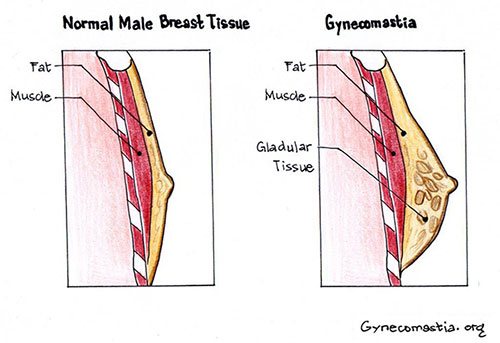
Evaluating Adult Gynecomastia
Before proceeding with male breast reduction surgery, your plastic surgeon will want to determine the direct cause of the condition.
A medical history may include the following:
- Age of onset and duration of the condition
- Any recent changes in nipple size and any pain or discharge from the nipples
- History of mumps, testicular trauma, alcohol use, or drug use
- Family history of gynecomastia
- History of sexual dysfunction, infertility, or hypogonadism (a condition in which the production of sex hormones and germ cells are inadequate)
A physical examination may include the following:
- Thorough examination of the breasts, with attention to size and consistency
- Assessment for any nipple discharge or axillary lymphadenopathy (obvious enlargement of lymph nodes in the area of the arm and breast)
- Testing to differentiate between true gynecomastia and pseudogynecomastia (enlarged breast tissue caused by fat accumulation)
- Assessment of glandular tissue
- Examination of the testicles, with attention to size and consistency, as well as nodules or asymmetry
- Observation of any signs of feminization
This evaluation can determine the etiology of the gynecomastia in many cases. If it does not, then a hormone or endocrine workup is appropriate to rule out an abnormal internal production of hormones, which may arise from a tumor.
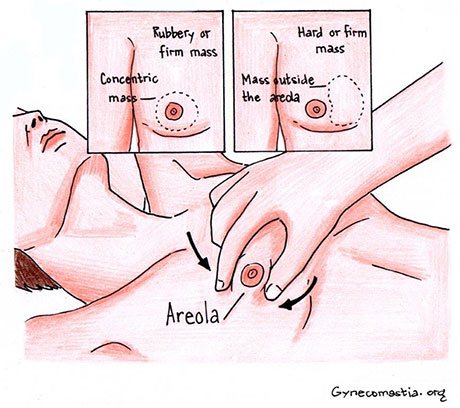
Diagnosing adult gynecomastia
A gynecomastia pinch test is a method used to diagnose gynecomastia. To properly diagnose adult gynecomastia, the doctor has the patient lie flat on his back with his hands clasped beneath his head. Using his separated thumb and forefinger, the doctor slowly brings the fingers together from either side of the breast. In patients with true gynecomastia, the doctor will feel a rubbery or firm mound of tissue surrounding the nipple and areola; whereas in patients with pseudo-gynecomastia, no such disk of tissue is found.
If the medical history does not pinpoint the etiology, then the doctor will conduct an endocrine or hormone evaluation. If the hormone levels are normal, the diagnosis is idiopathic or of “unknown etiology.”
Examples of Adult Gynecomastia
Adult Gynecomastia and Pseudogynecomastia
Unlike gynecomastia, in which the male breast is enlarged due to glandular tissue, pseudogynecomastia development is due to increase in fat deposits. The condition is usually attributed to weight gain and/or aging. The average pseudogynecomastia patient states that as a teenager their chest was normal, but the condition developed later in life as they gained weight and aged. A pseudogynecomastia patient will often get a pleasing result with just liposuction.

Male Menopause
The term “male menopause” is sometimes used to describe decreasing testosterone levels related to aging. Many physicians also use the term “andropause” to describe age-related hormone changes in men. Other medical terms describe this condition as well, including testosterone deficiency syndrome, androgen deficiency of the aging male, and late-onset male hypogonadism. Regardless of the term, it describes decreasing testosterone levels with advanced aging. The chart below illustrates the slow decline in testosterone levels in the bloodstream.
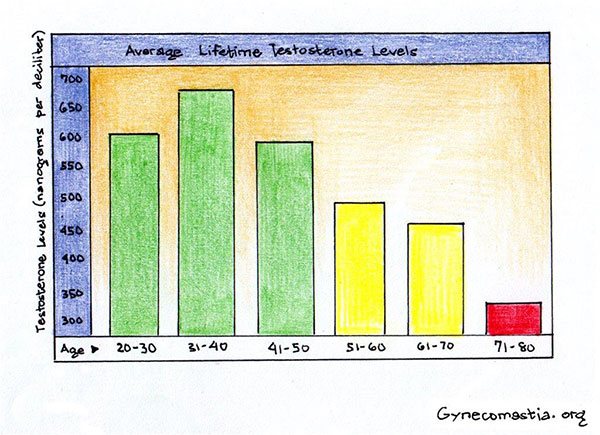
Low Testosterone Levels (Low-T)
Testosterone is a powerful male hormone produced in the testicles; it is responsible for stimulating sperm production and sex drive. It is also responsible for bone density and muscle mass. “Low T” is a common term for low testosterone levels. The reduced testosterone triggers a syndrome known as male menopause or “andropause.” As men age, testosterone production naturally declines, which can cause a variety of symptoms, including male breast enlargement. Signs of low testosterone often go undetected and are mistaken as a natural part of aging.
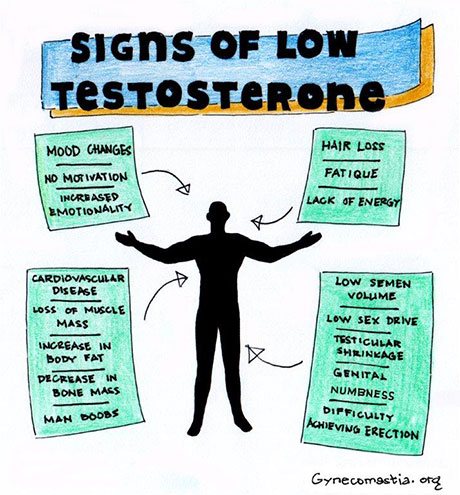
What is the Difference Between Male and Female Menopause?
When women go into menopause, ovulation stops and hormone production rapidly decreases in a relatively short time span. In men, the production of testosterone declines over a period of many years. The symptoms arise gradually and are often unrecognized.
8 Signs and Symptoms of Male Menopause
A serum testosterone blood test is the best way to determine a low or reduced testosterone level. It is not uncommon for men who have a lower-than-normal testosterone level to show minimal or no signs or symptoms. In these cases, no treatment is necessary. Following are the eight signs and symptoms of male menopause:
- Reduced libido: Testosterone plays a major role in the male sex drive. As men age and testosterone levels decrease, so does their sex drive.
- Reduced semen volume: Testosterone is vital to semen production; the fluid that assists in sperm motility. The more testosterone a man has, the greater his semen production.
- Loss or reduction of facial and body hair
- Lack of overall energy, or fatigue
- Loss of muscle mass and strength, especially in the arms, legs, or chest
- Increase in total body fat
- Reduced bone mass (osteoporosis)
- Mood changes: Testosterone is considered a “fuel” for men. It is a hormone that controls multiple body systems, as well as mental health and mood. Men with low testosterone are more likely to experience depression, short attention span, and irritability.
For a closer look at the controversy surrounding the pros and cons of testosterone replacement, read the Time Magazine article: Are You Man Enough? The Truth About Low Testosterone.
There are many drugs that are used for medical treatment that have the side effect of gynecomastia. These are some of the most common:
- Calcium channel blockers used for controlling high blood pressure
- Spironolactone (Aldactone), a diuretic that also has anti-androgen capabilities
- ACE inhibitor medications for high blood pressure such as captopril (Capoten) and enalapril (Vasotec)
- Various antibiotics such as isoniazid, metronidazole (Flagyl), and ketoconazole (Nizoral, Kuric, Xolegel, Extina)
- Anti-ulcer drugs including cimetidine (Tagamet), ranitidine (Zantac), and omeprazole (Prilosec)
- Anti-androgen therapy for cancer of the prostate
- Methyldopa (Aldomet), used to treat hypertension
- Highly active anti-retroviral therapy (HAART) for the treatment of HIV. The drug can lead to fat accumulation, which may in turn lead to pseudo-gynecomastia or true gynecomastia
- Diazepam (Valium), an anti-depressant
- Digitoxin, a heart medication
- Drugs such as marijuana, alcohol, and heroin
- Skincare products containing tea tree and lavender oils
Treatment for Adult Gynecomastia
Male breast reduction surgery is the treatment of choice for adult gynecomastia. This is an extremely successful procedure, but the decision to undertake it obviously depends on the grade of gynecomastia.
Conclusion
Adult gynecomastia is a very common condition that results in enlarged male breasts that can have a negative impact on men’s confidence and lifestyle. The reasons someone would develop gynecomastia are complex and multifactorial. As men age, the male hormones gradually decline, resulting in a series of signs and symptoms of male menopause. The treatment of choice is male breast reduction surgery.
©Copyright 2020 Gynecomastia.org. All rights reserved. Use and access to this site are subject to the terms and conditions as set out in our Legal Statement and Privacy Statement.
The content on Gynecomastia.org is for educational purposes only. It is not intended as medical advice. It does not replace the need to meet with a physician who will accurately diagnose your condition and suggest treatment options.



